Team Leader Meeting Debriefing Report
VerifiedAdded on 2020/03/23
|10
|1639
|108
AI Summary
This document is a debriefing report from a team leader meeting held on September 26th, 2017. The focus of the meeting was to address an incident involving an employee named Tim who allegedly caused harm to two volunteers. The meeting involved a discussion on disciplinary actions against Tim, ensuring his accountability, and providing support and compensation to the affected volunteers. The report outlines the stages of the debriefing process, topics covered, referral recommendations for future incidents, and a final reflection on promoting peace and harmony within the organization.
Contribute Materials
Your contribution can guide someone’s learning journey. Share your
documents today.
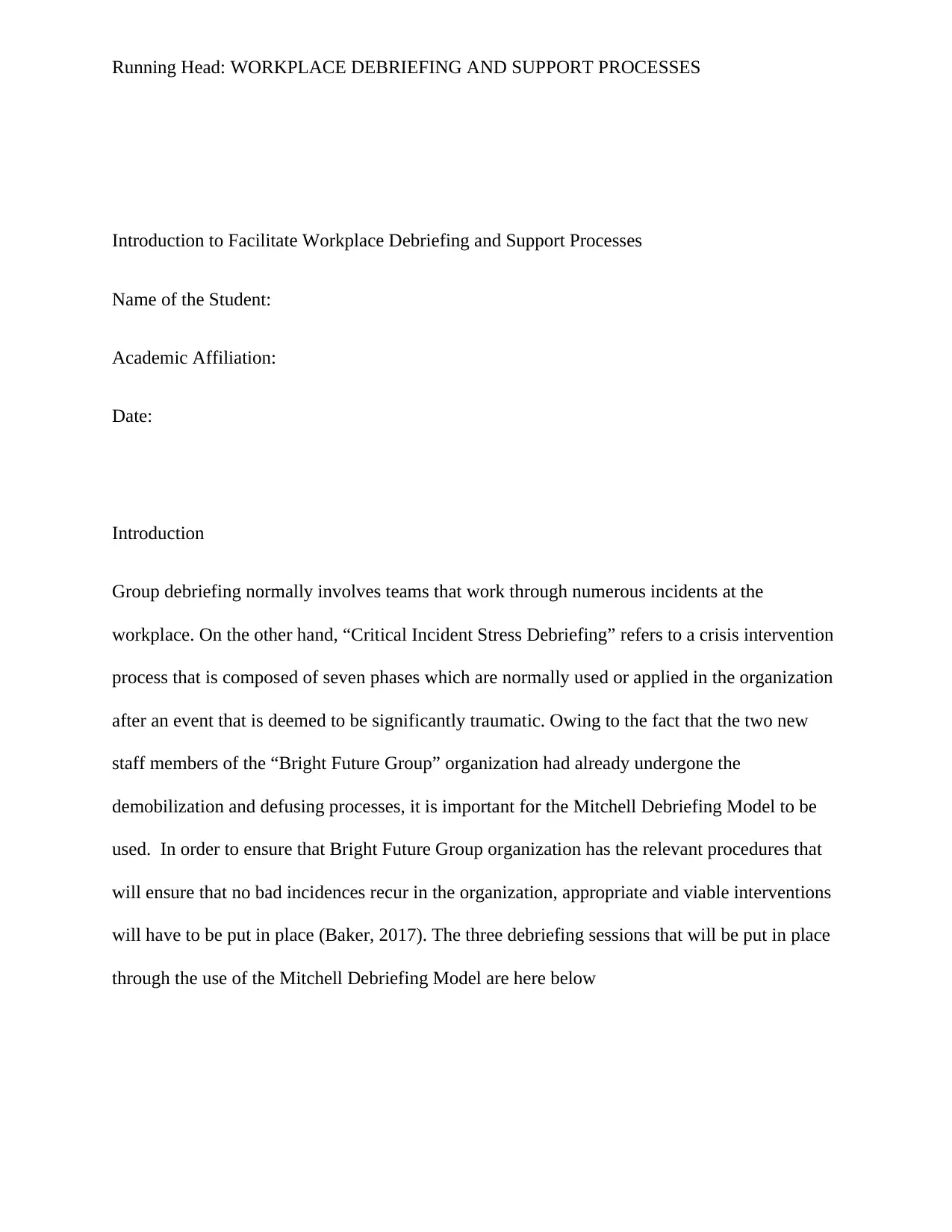
Running Head: WORKPLACE DEBRIEFING AND SUPPORT PROCESSES
Introduction to Facilitate Workplace Debriefing and Support Processes
Name of the Student:
Academic Affiliation:
Date:
Introduction
Group debriefing normally involves teams that work through numerous incidents at the
workplace. On the other hand, “Critical Incident Stress Debriefing” refers to a crisis intervention
process that is composed of seven phases which are normally used or applied in the organization
after an event that is deemed to be significantly traumatic. Owing to the fact that the two new
staff members of the “Bright Future Group” organization had already undergone the
demobilization and defusing processes, it is important for the Mitchell Debriefing Model to be
used. In order to ensure that Bright Future Group organization has the relevant procedures that
will ensure that no bad incidences recur in the organization, appropriate and viable interventions
will have to be put in place (Baker, 2017). The three debriefing sessions that will be put in place
through the use of the Mitchell Debriefing Model are here below
Introduction to Facilitate Workplace Debriefing and Support Processes
Name of the Student:
Academic Affiliation:
Date:
Introduction
Group debriefing normally involves teams that work through numerous incidents at the
workplace. On the other hand, “Critical Incident Stress Debriefing” refers to a crisis intervention
process that is composed of seven phases which are normally used or applied in the organization
after an event that is deemed to be significantly traumatic. Owing to the fact that the two new
staff members of the “Bright Future Group” organization had already undergone the
demobilization and defusing processes, it is important for the Mitchell Debriefing Model to be
used. In order to ensure that Bright Future Group organization has the relevant procedures that
will ensure that no bad incidences recur in the organization, appropriate and viable interventions
will have to be put in place (Baker, 2017). The three debriefing sessions that will be put in place
through the use of the Mitchell Debriefing Model are here below
Secure Best Marks with AI Grader
Need help grading? Try our AI Grader for instant feedback on your assignments.
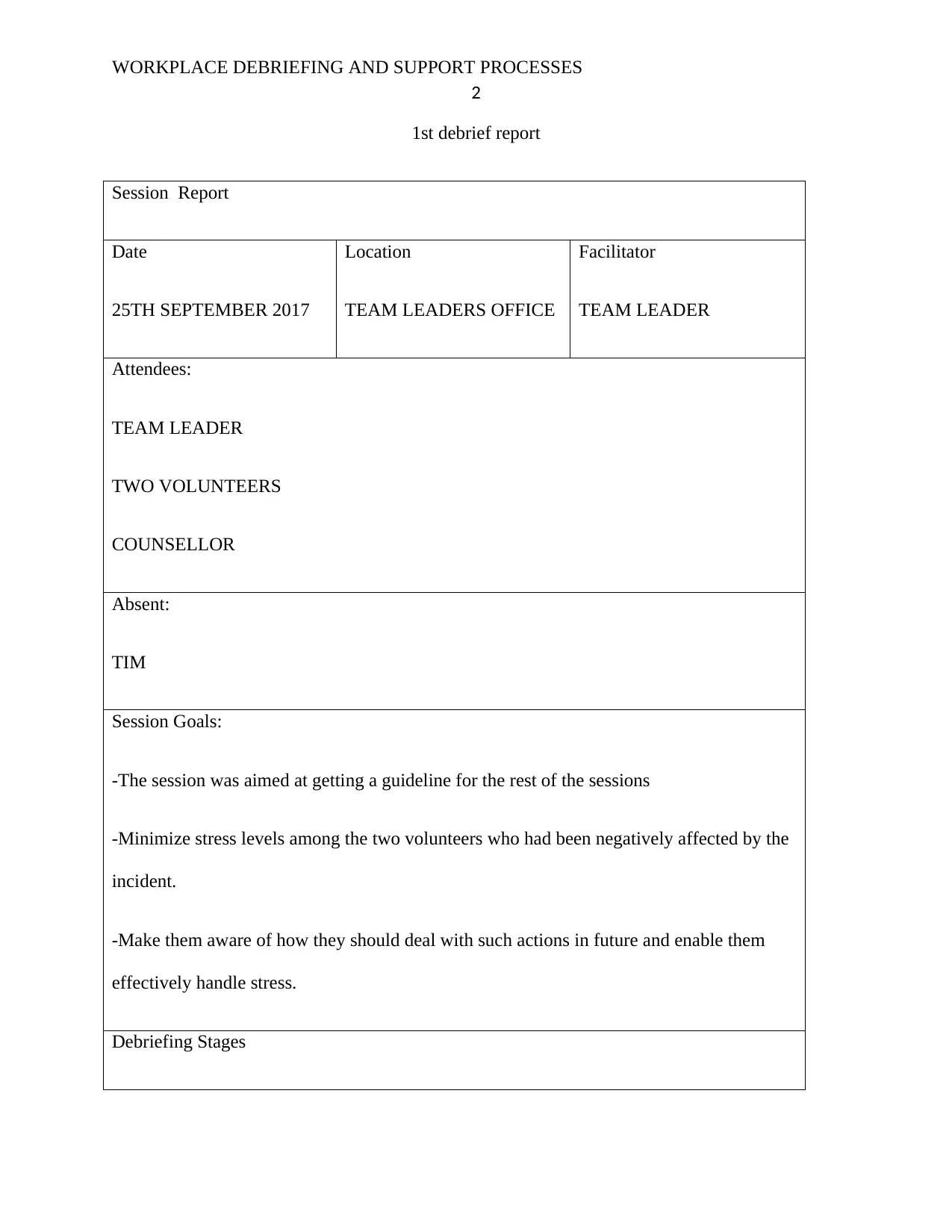
WORKPLACE DEBRIEFING AND SUPPORT PROCESSES
2
1st debrief report
Session Report
Date
25TH SEPTEMBER 2017
Location
TEAM LEADERS OFFICE
Facilitator
TEAM LEADER
Attendees:
TEAM LEADER
TWO VOLUNTEERS
COUNSELLOR
Absent:
TIM
Session Goals:
-The session was aimed at getting a guideline for the rest of the sessions
-Minimize stress levels among the two volunteers who had been negatively affected by the
incident.
-Make them aware of how they should deal with such actions in future and enable them
effectively handle stress.
Debriefing Stages
2
1st debrief report
Session Report
Date
25TH SEPTEMBER 2017
Location
TEAM LEADERS OFFICE
Facilitator
TEAM LEADER
Attendees:
TEAM LEADER
TWO VOLUNTEERS
COUNSELLOR
Absent:
TIM
Session Goals:
-The session was aimed at getting a guideline for the rest of the sessions
-Minimize stress levels among the two volunteers who had been negatively affected by the
incident.
-Make them aware of how they should deal with such actions in future and enable them
effectively handle stress.
Debriefing Stages
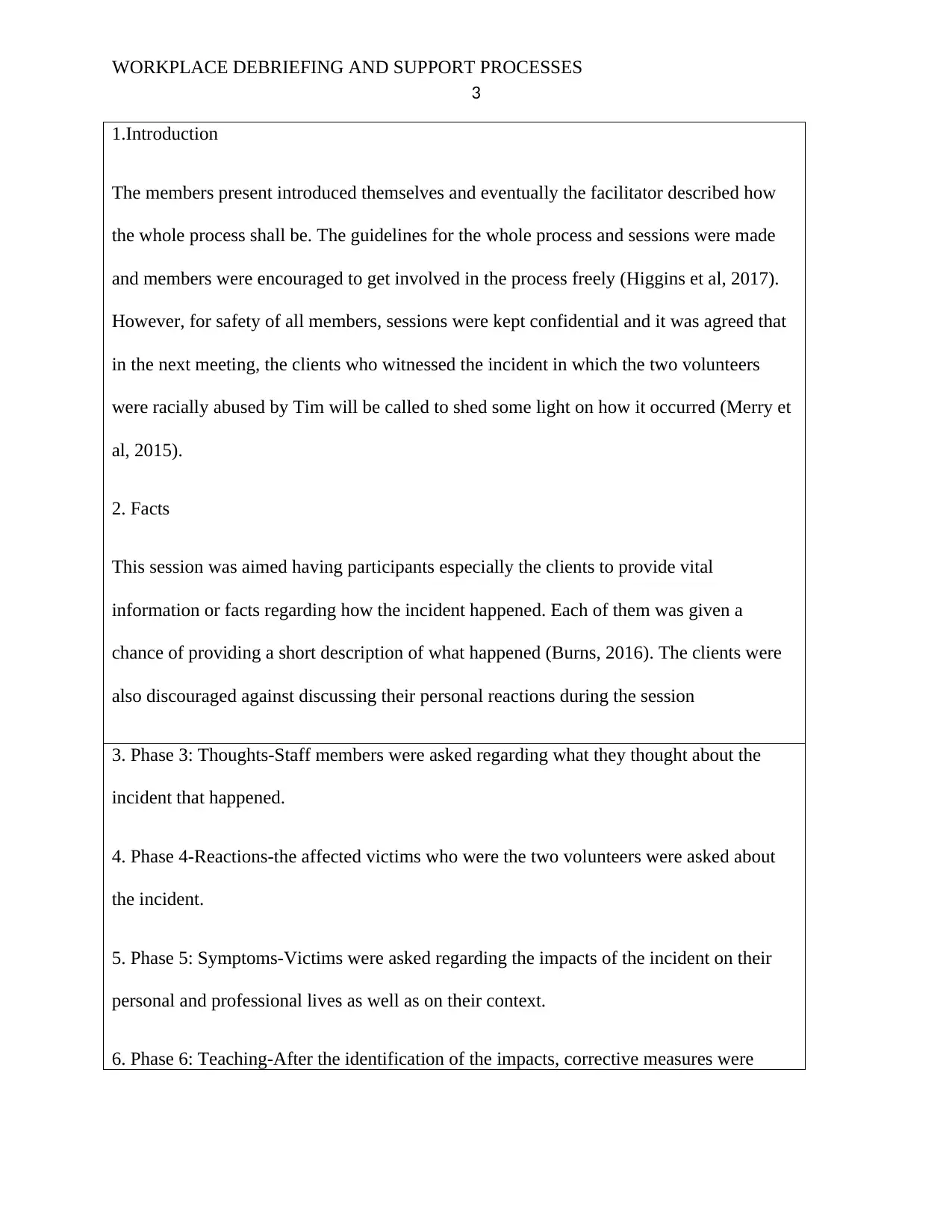
WORKPLACE DEBRIEFING AND SUPPORT PROCESSES
3
1.Introduction
The members present introduced themselves and eventually the facilitator described how
the whole process shall be. The guidelines for the whole process and sessions were made
and members were encouraged to get involved in the process freely (Higgins et al, 2017).
However, for safety of all members, sessions were kept confidential and it was agreed that
in the next meeting, the clients who witnessed the incident in which the two volunteers
were racially abused by Tim will be called to shed some light on how it occurred (Merry et
al, 2015).
2. Facts
This session was aimed having participants especially the clients to provide vital
information or facts regarding how the incident happened. Each of them was given a
chance of providing a short description of what happened (Burns, 2016). The clients were
also discouraged against discussing their personal reactions during the session
3. Phase 3: Thoughts-Staff members were asked regarding what they thought about the
incident that happened.
4. Phase 4-Reactions-the affected victims who were the two volunteers were asked about
the incident.
5. Phase 5: Symptoms-Victims were asked regarding the impacts of the incident on their
personal and professional lives as well as on their context.
6. Phase 6: Teaching-After the identification of the impacts, corrective measures were
3
1.Introduction
The members present introduced themselves and eventually the facilitator described how
the whole process shall be. The guidelines for the whole process and sessions were made
and members were encouraged to get involved in the process freely (Higgins et al, 2017).
However, for safety of all members, sessions were kept confidential and it was agreed that
in the next meeting, the clients who witnessed the incident in which the two volunteers
were racially abused by Tim will be called to shed some light on how it occurred (Merry et
al, 2015).
2. Facts
This session was aimed having participants especially the clients to provide vital
information or facts regarding how the incident happened. Each of them was given a
chance of providing a short description of what happened (Burns, 2016). The clients were
also discouraged against discussing their personal reactions during the session
3. Phase 3: Thoughts-Staff members were asked regarding what they thought about the
incident that happened.
4. Phase 4-Reactions-the affected victims who were the two volunteers were asked about
the incident.
5. Phase 5: Symptoms-Victims were asked regarding the impacts of the incident on their
personal and professional lives as well as on their context.
6. Phase 6: Teaching-After the identification of the impacts, corrective measures were
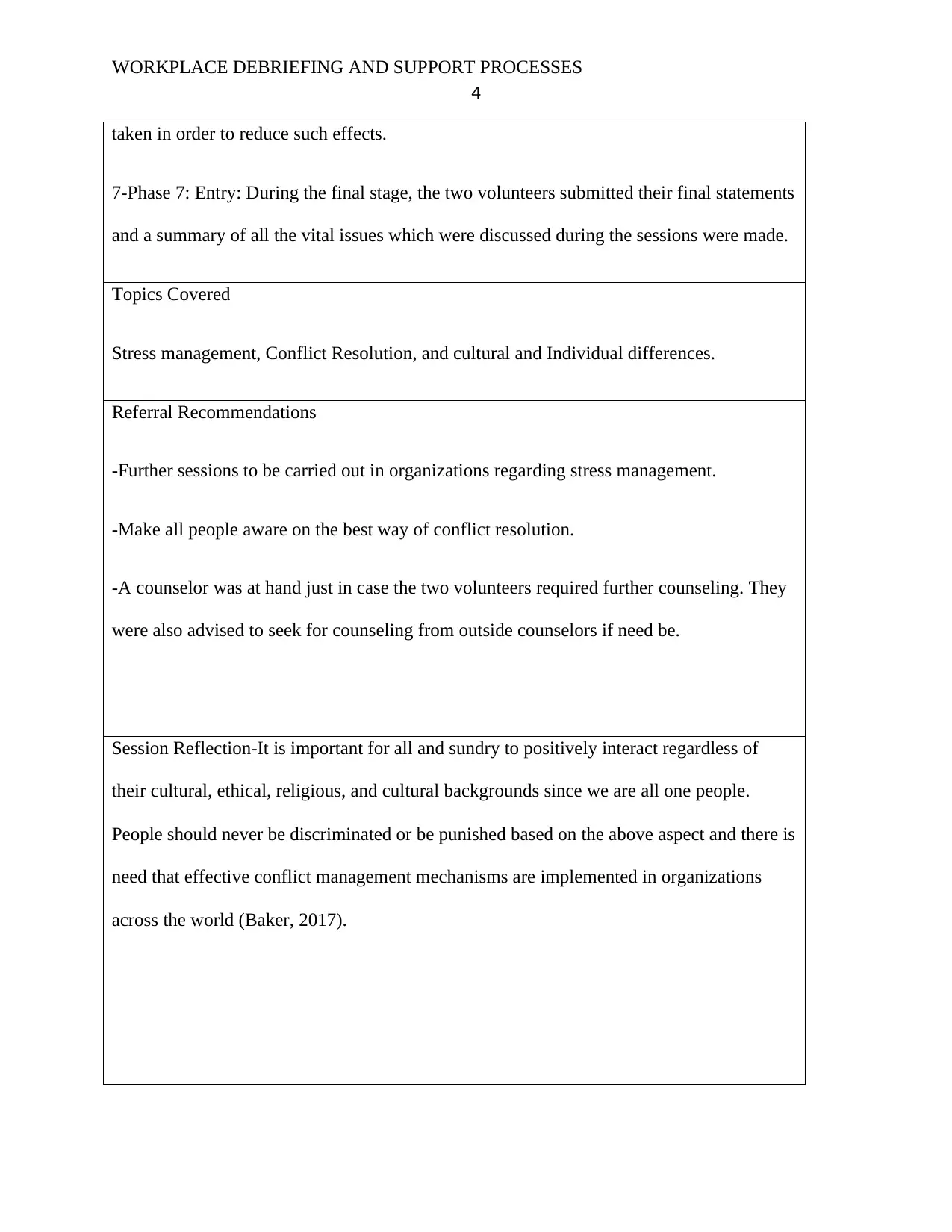
WORKPLACE DEBRIEFING AND SUPPORT PROCESSES
4
taken in order to reduce such effects.
7-Phase 7: Entry: During the final stage, the two volunteers submitted their final statements
and a summary of all the vital issues which were discussed during the sessions were made.
Topics Covered
Stress management, Conflict Resolution, and cultural and Individual differences.
Referral Recommendations
-Further sessions to be carried out in organizations regarding stress management.
-Make all people aware on the best way of conflict resolution.
-A counselor was at hand just in case the two volunteers required further counseling. They
were also advised to seek for counseling from outside counselors if need be.
Session Reflection-It is important for all and sundry to positively interact regardless of
their cultural, ethical, religious, and cultural backgrounds since we are all one people.
People should never be discriminated or be punished based on the above aspect and there is
need that effective conflict management mechanisms are implemented in organizations
across the world (Baker, 2017).
4
taken in order to reduce such effects.
7-Phase 7: Entry: During the final stage, the two volunteers submitted their final statements
and a summary of all the vital issues which were discussed during the sessions were made.
Topics Covered
Stress management, Conflict Resolution, and cultural and Individual differences.
Referral Recommendations
-Further sessions to be carried out in organizations regarding stress management.
-Make all people aware on the best way of conflict resolution.
-A counselor was at hand just in case the two volunteers required further counseling. They
were also advised to seek for counseling from outside counselors if need be.
Session Reflection-It is important for all and sundry to positively interact regardless of
their cultural, ethical, religious, and cultural backgrounds since we are all one people.
People should never be discriminated or be punished based on the above aspect and there is
need that effective conflict management mechanisms are implemented in organizations
across the world (Baker, 2017).
Secure Best Marks with AI Grader
Need help grading? Try our AI Grader for instant feedback on your assignments.
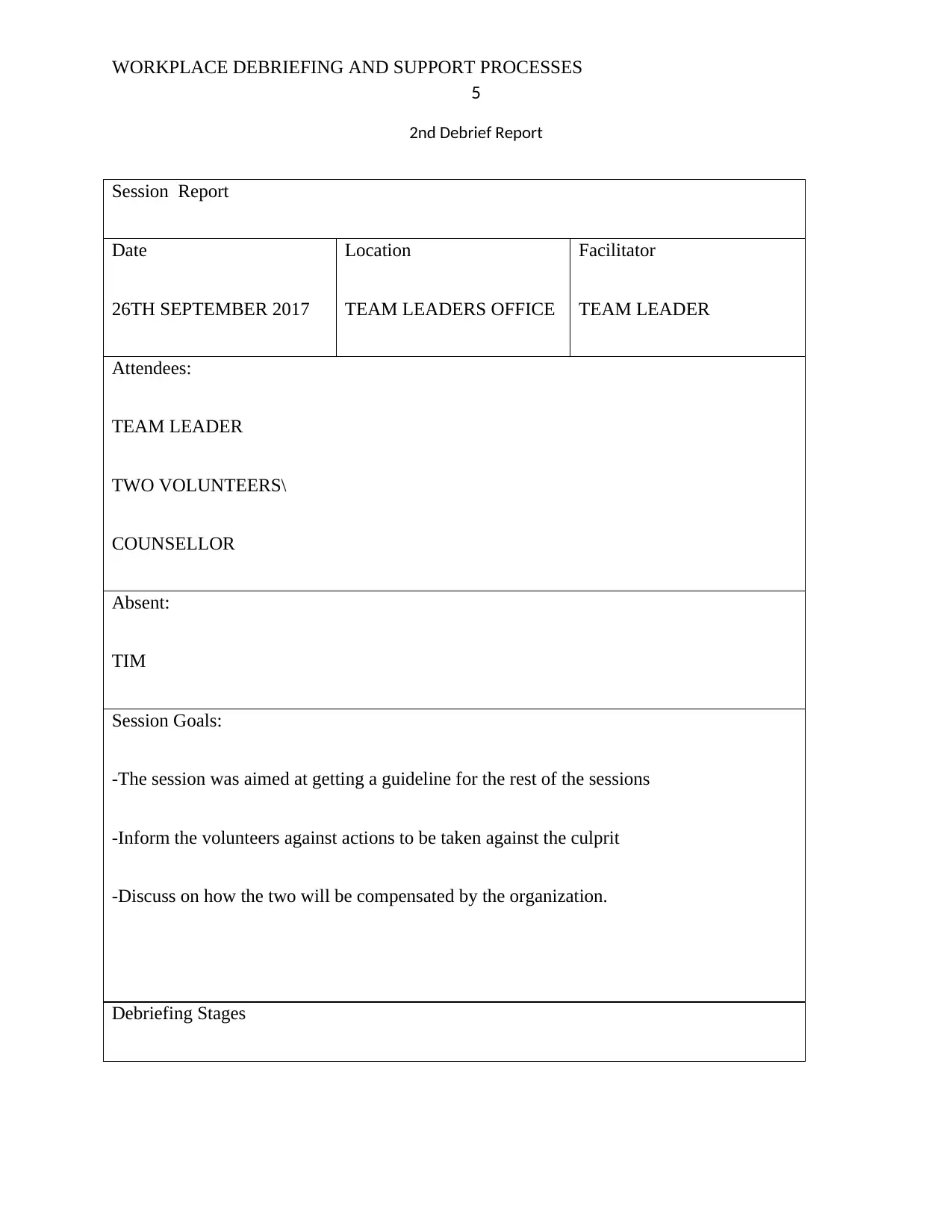
WORKPLACE DEBRIEFING AND SUPPORT PROCESSES
5
2nd Debrief Report
Session Report
Date
26TH SEPTEMBER 2017
Location
TEAM LEADERS OFFICE
Facilitator
TEAM LEADER
Attendees:
TEAM LEADER
TWO VOLUNTEERS\
COUNSELLOR
Absent:
TIM
Session Goals:
-The session was aimed at getting a guideline for the rest of the sessions
-Inform the volunteers against actions to be taken against the culprit
-Discuss on how the two will be compensated by the organization.
Debriefing Stages
5
2nd Debrief Report
Session Report
Date
26TH SEPTEMBER 2017
Location
TEAM LEADERS OFFICE
Facilitator
TEAM LEADER
Attendees:
TEAM LEADER
TWO VOLUNTEERS\
COUNSELLOR
Absent:
TIM
Session Goals:
-The session was aimed at getting a guideline for the rest of the sessions
-Inform the volunteers against actions to be taken against the culprit
-Discuss on how the two will be compensated by the organization.
Debriefing Stages
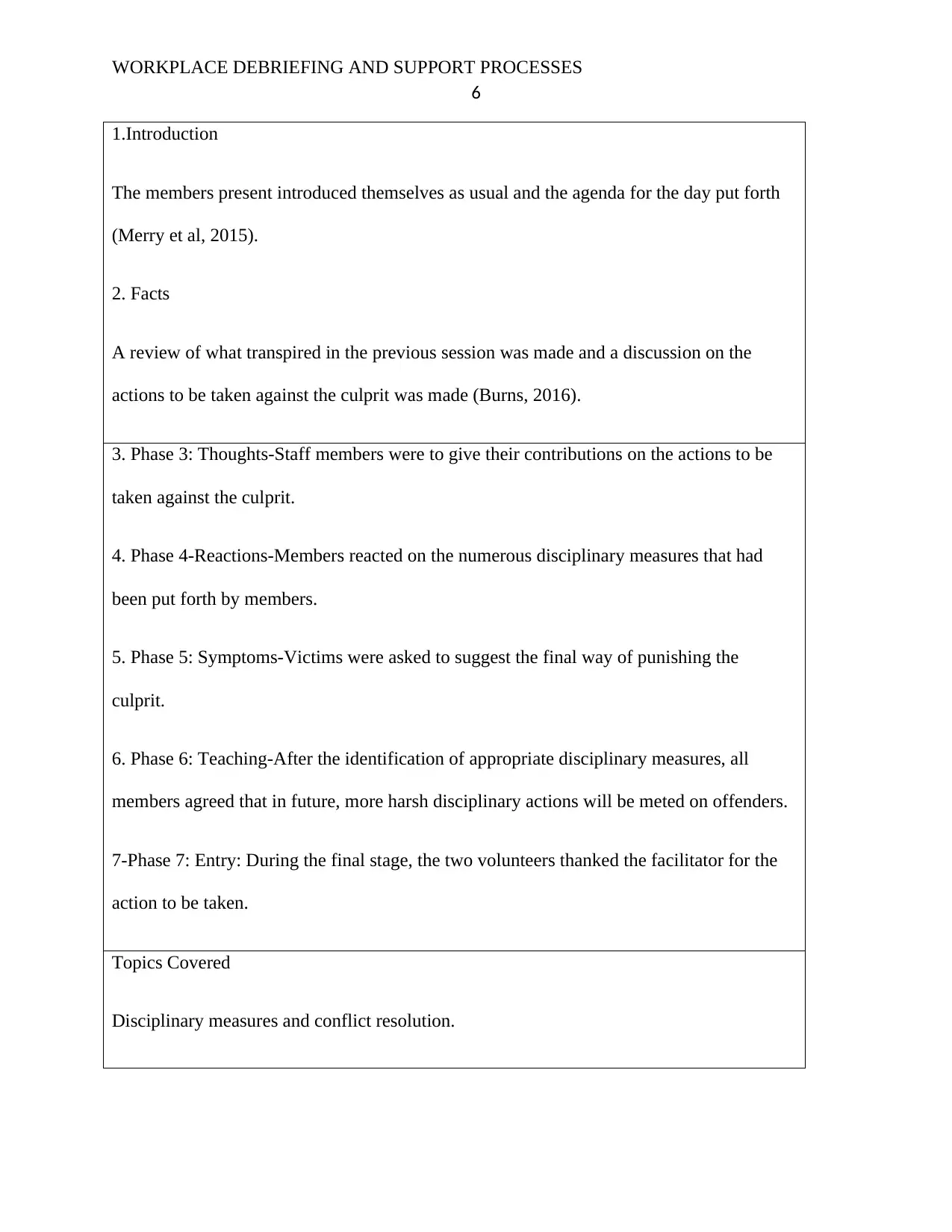
WORKPLACE DEBRIEFING AND SUPPORT PROCESSES
6
1.Introduction
The members present introduced themselves as usual and the agenda for the day put forth
(Merry et al, 2015).
2. Facts
A review of what transpired in the previous session was made and a discussion on the
actions to be taken against the culprit was made (Burns, 2016).
3. Phase 3: Thoughts-Staff members were to give their contributions on the actions to be
taken against the culprit.
4. Phase 4-Reactions-Members reacted on the numerous disciplinary measures that had
been put forth by members.
5. Phase 5: Symptoms-Victims were asked to suggest the final way of punishing the
culprit.
6. Phase 6: Teaching-After the identification of appropriate disciplinary measures, all
members agreed that in future, more harsh disciplinary actions will be meted on offenders.
7-Phase 7: Entry: During the final stage, the two volunteers thanked the facilitator for the
action to be taken.
Topics Covered
Disciplinary measures and conflict resolution.
6
1.Introduction
The members present introduced themselves as usual and the agenda for the day put forth
(Merry et al, 2015).
2. Facts
A review of what transpired in the previous session was made and a discussion on the
actions to be taken against the culprit was made (Burns, 2016).
3. Phase 3: Thoughts-Staff members were to give their contributions on the actions to be
taken against the culprit.
4. Phase 4-Reactions-Members reacted on the numerous disciplinary measures that had
been put forth by members.
5. Phase 5: Symptoms-Victims were asked to suggest the final way of punishing the
culprit.
6. Phase 6: Teaching-After the identification of appropriate disciplinary measures, all
members agreed that in future, more harsh disciplinary actions will be meted on offenders.
7-Phase 7: Entry: During the final stage, the two volunteers thanked the facilitator for the
action to be taken.
Topics Covered
Disciplinary measures and conflict resolution.
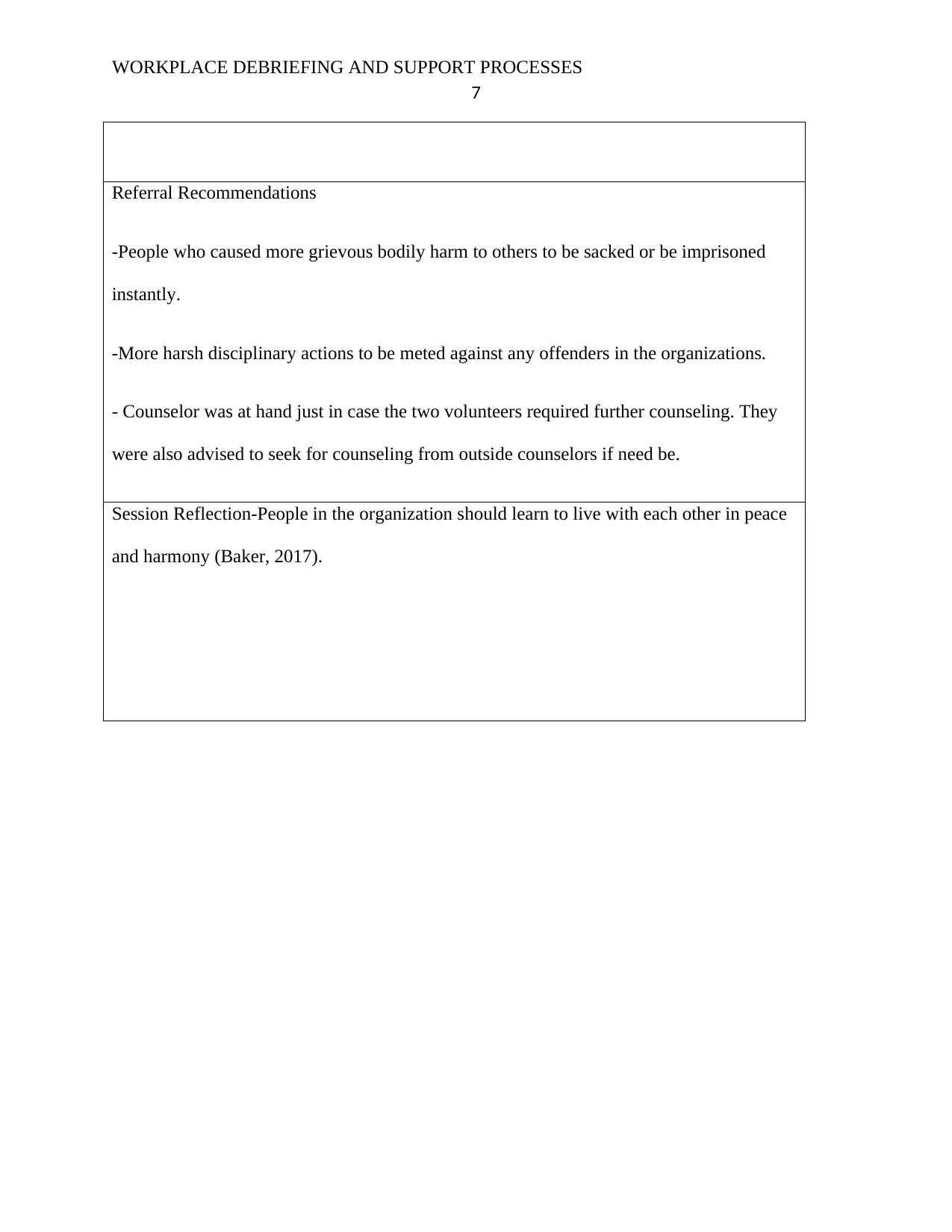
WORKPLACE DEBRIEFING AND SUPPORT PROCESSES
7
Referral Recommendations
-People who caused more grievous bodily harm to others to be sacked or be imprisoned
instantly.
-More harsh disciplinary actions to be meted against any offenders in the organizations.
- Counselor was at hand just in case the two volunteers required further counseling. They
were also advised to seek for counseling from outside counselors if need be.
Session Reflection-People in the organization should learn to live with each other in peace
and harmony (Baker, 2017).
7
Referral Recommendations
-People who caused more grievous bodily harm to others to be sacked or be imprisoned
instantly.
-More harsh disciplinary actions to be meted against any offenders in the organizations.
- Counselor was at hand just in case the two volunteers required further counseling. They
were also advised to seek for counseling from outside counselors if need be.
Session Reflection-People in the organization should learn to live with each other in peace
and harmony (Baker, 2017).
Paraphrase This Document
Need a fresh take? Get an instant paraphrase of this document with our AI Paraphraser
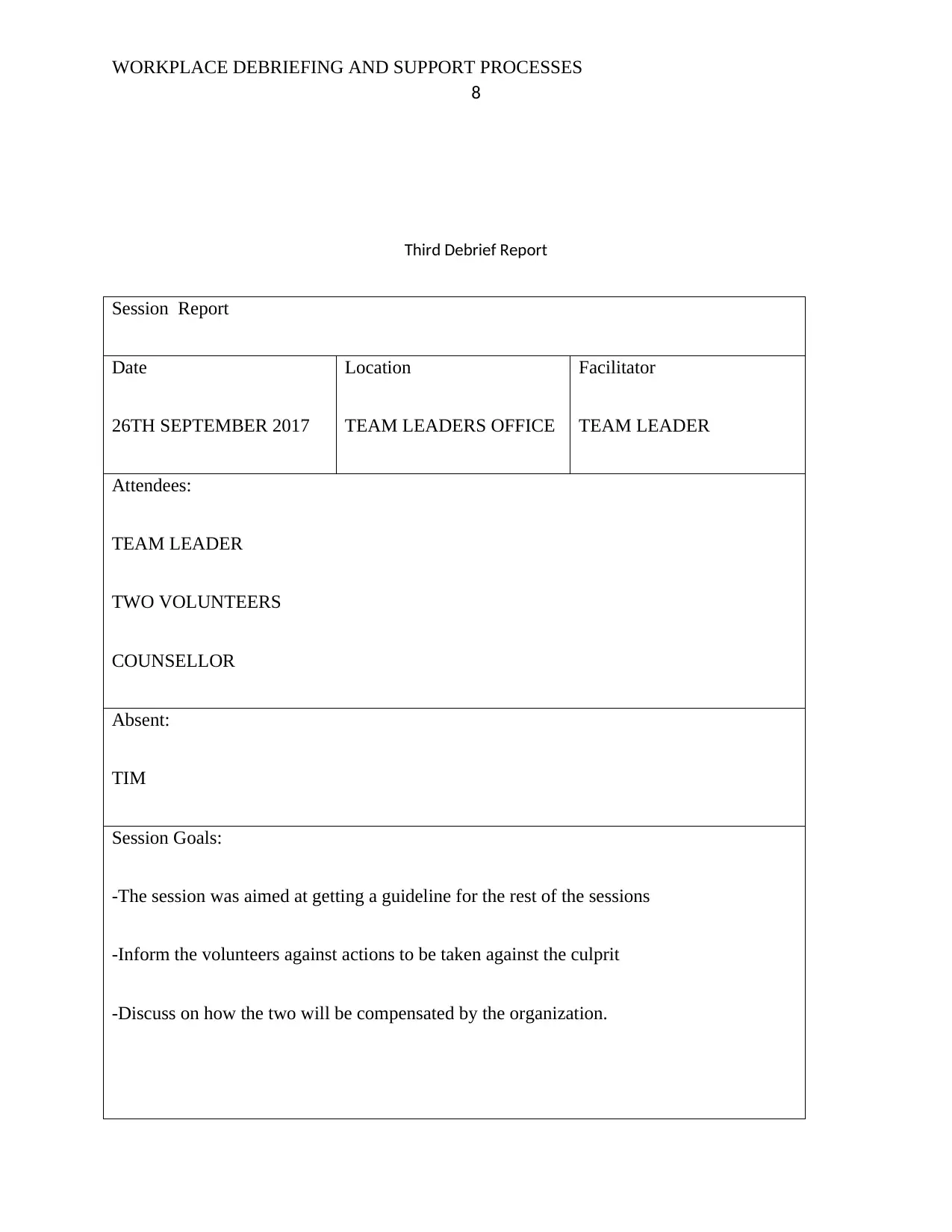
WORKPLACE DEBRIEFING AND SUPPORT PROCESSES
8
Third Debrief Report
Session Report
Date
26TH SEPTEMBER 2017
Location
TEAM LEADERS OFFICE
Facilitator
TEAM LEADER
Attendees:
TEAM LEADER
TWO VOLUNTEERS
COUNSELLOR
Absent:
TIM
Session Goals:
-The session was aimed at getting a guideline for the rest of the sessions
-Inform the volunteers against actions to be taken against the culprit
-Discuss on how the two will be compensated by the organization.
8
Third Debrief Report
Session Report
Date
26TH SEPTEMBER 2017
Location
TEAM LEADERS OFFICE
Facilitator
TEAM LEADER
Attendees:
TEAM LEADER
TWO VOLUNTEERS
COUNSELLOR
Absent:
TIM
Session Goals:
-The session was aimed at getting a guideline for the rest of the sessions
-Inform the volunteers against actions to be taken against the culprit
-Discuss on how the two will be compensated by the organization.
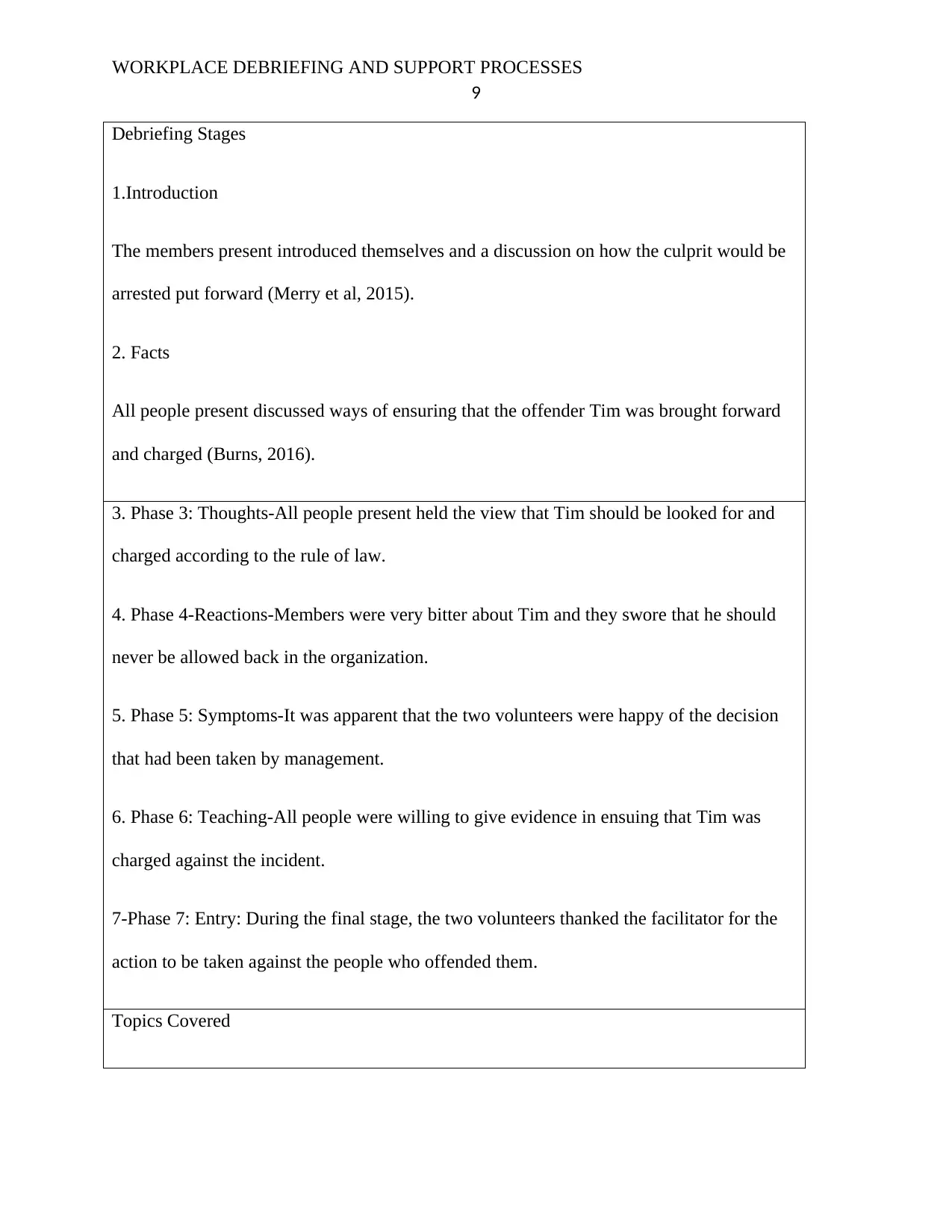
WORKPLACE DEBRIEFING AND SUPPORT PROCESSES
9
Debriefing Stages
1.Introduction
The members present introduced themselves and a discussion on how the culprit would be
arrested put forward (Merry et al, 2015).
2. Facts
All people present discussed ways of ensuring that the offender Tim was brought forward
and charged (Burns, 2016).
3. Phase 3: Thoughts-All people present held the view that Tim should be looked for and
charged according to the rule of law.
4. Phase 4-Reactions-Members were very bitter about Tim and they swore that he should
never be allowed back in the organization.
5. Phase 5: Symptoms-It was apparent that the two volunteers were happy of the decision
that had been taken by management.
6. Phase 6: Teaching-All people were willing to give evidence in ensuing that Tim was
charged against the incident.
7-Phase 7: Entry: During the final stage, the two volunteers thanked the facilitator for the
action to be taken against the people who offended them.
Topics Covered
9
Debriefing Stages
1.Introduction
The members present introduced themselves and a discussion on how the culprit would be
arrested put forward (Merry et al, 2015).
2. Facts
All people present discussed ways of ensuring that the offender Tim was brought forward
and charged (Burns, 2016).
3. Phase 3: Thoughts-All people present held the view that Tim should be looked for and
charged according to the rule of law.
4. Phase 4-Reactions-Members were very bitter about Tim and they swore that he should
never be allowed back in the organization.
5. Phase 5: Symptoms-It was apparent that the two volunteers were happy of the decision
that had been taken by management.
6. Phase 6: Teaching-All people were willing to give evidence in ensuing that Tim was
charged against the incident.
7-Phase 7: Entry: During the final stage, the two volunteers thanked the facilitator for the
action to be taken against the people who offended them.
Topics Covered
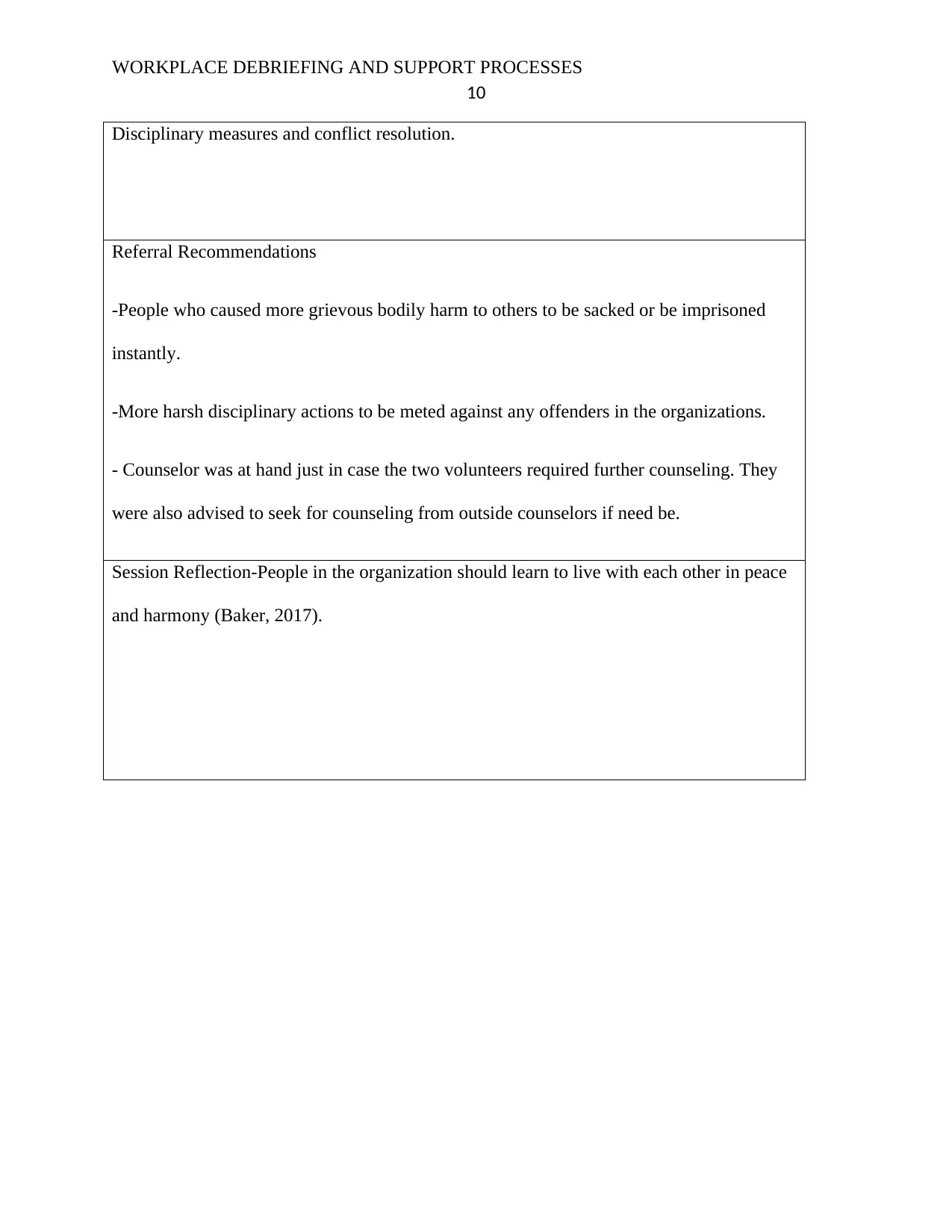
WORKPLACE DEBRIEFING AND SUPPORT PROCESSES
10
Disciplinary measures and conflict resolution.
Referral Recommendations
-People who caused more grievous bodily harm to others to be sacked or be imprisoned
instantly.
-More harsh disciplinary actions to be meted against any offenders in the organizations.
- Counselor was at hand just in case the two volunteers required further counseling. They
were also advised to seek for counseling from outside counselors if need be.
Session Reflection-People in the organization should learn to live with each other in peace
and harmony (Baker, 2017).
10
Disciplinary measures and conflict resolution.
Referral Recommendations
-People who caused more grievous bodily harm to others to be sacked or be imprisoned
instantly.
-More harsh disciplinary actions to be meted against any offenders in the organizations.
- Counselor was at hand just in case the two volunteers required further counseling. They
were also advised to seek for counseling from outside counselors if need be.
Session Reflection-People in the organization should learn to live with each other in peace
and harmony (Baker, 2017).
1 out of 10
Related Documents
Your All-in-One AI-Powered Toolkit for Academic Success.
+13062052269
info@desklib.com
Available 24*7 on WhatsApp / Email
![[object Object]](/_next/static/media/star-bottom.7253800d.svg)
Unlock your academic potential
© 2024 | Zucol Services PVT LTD | All rights reserved.
